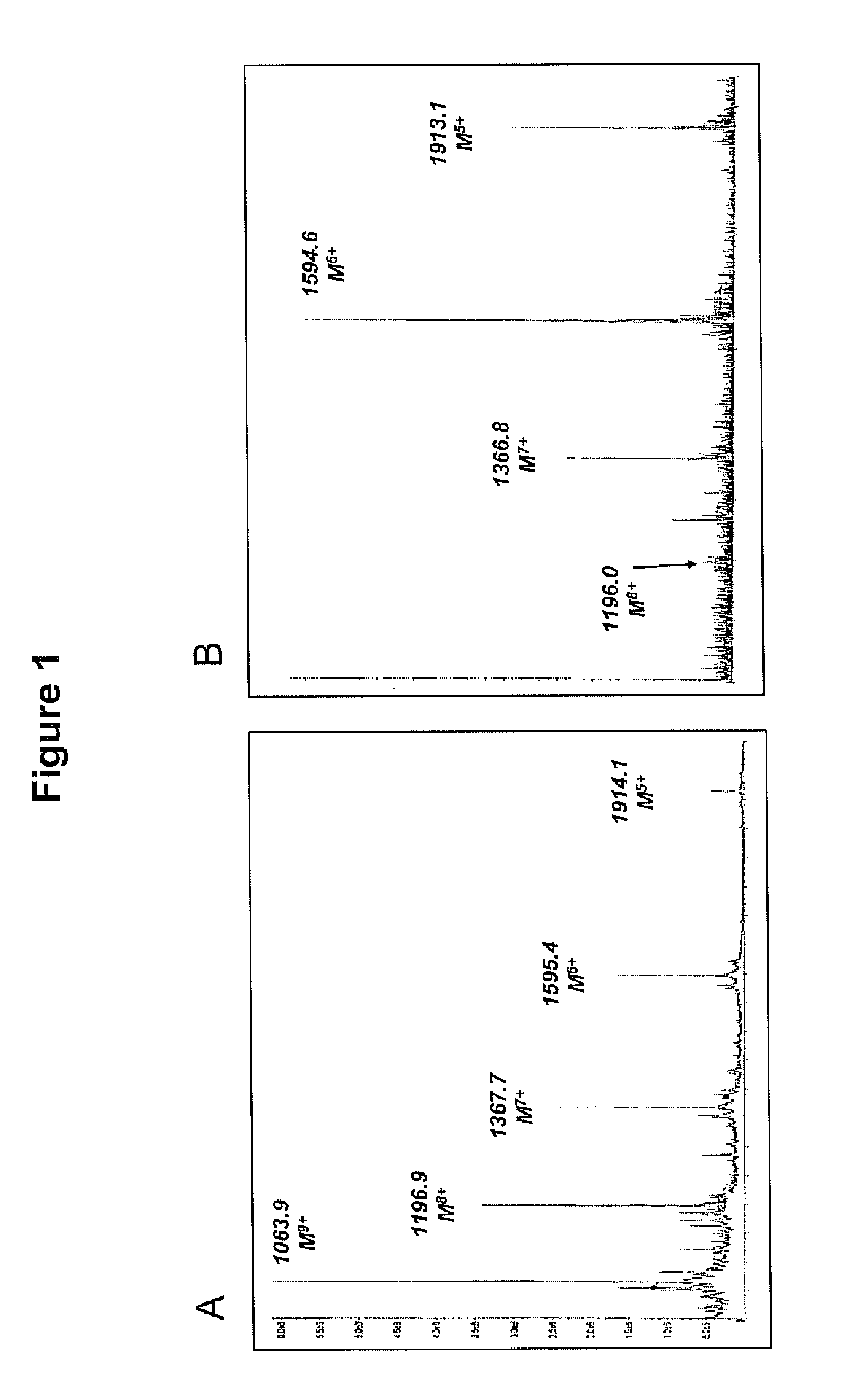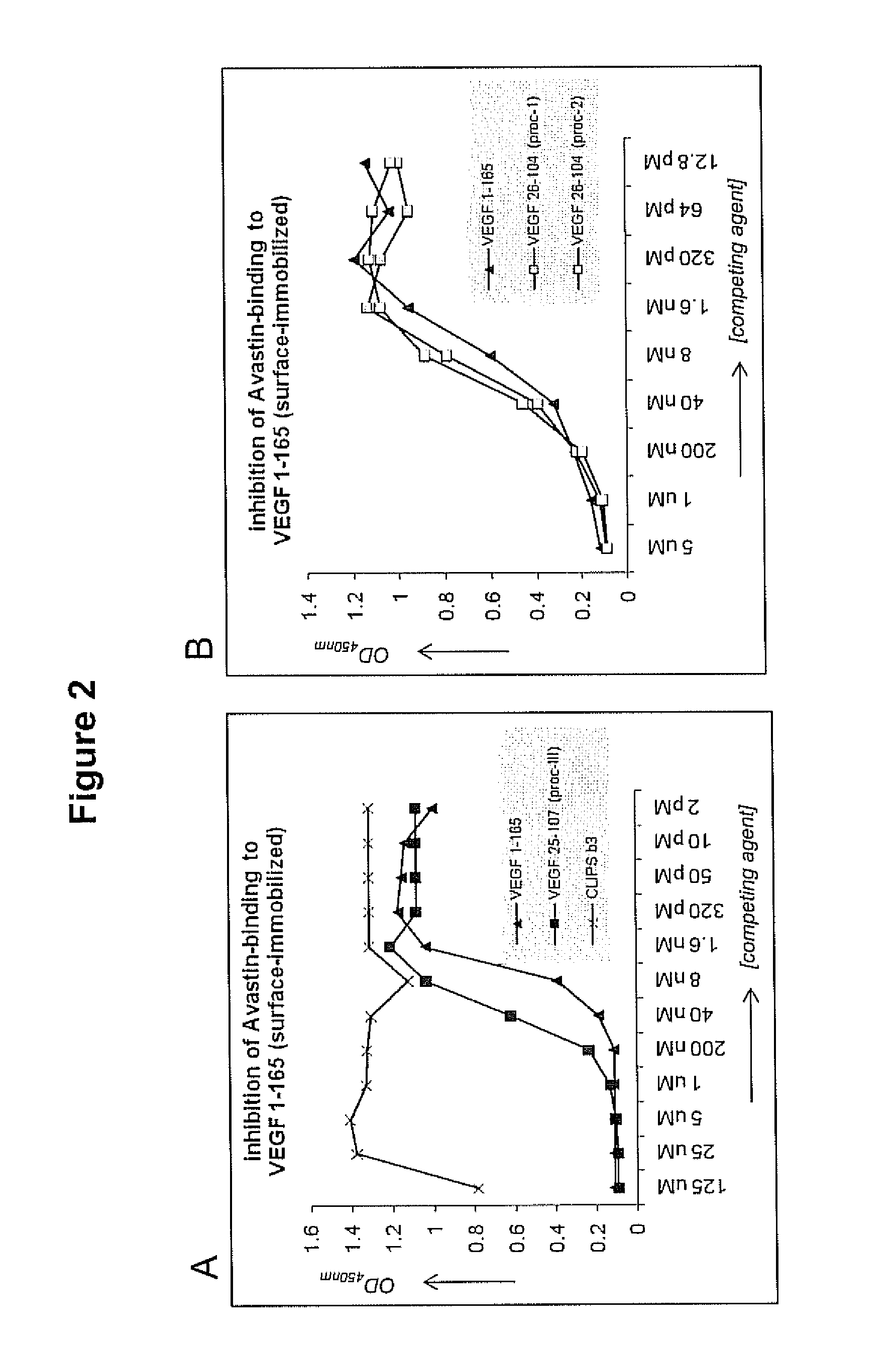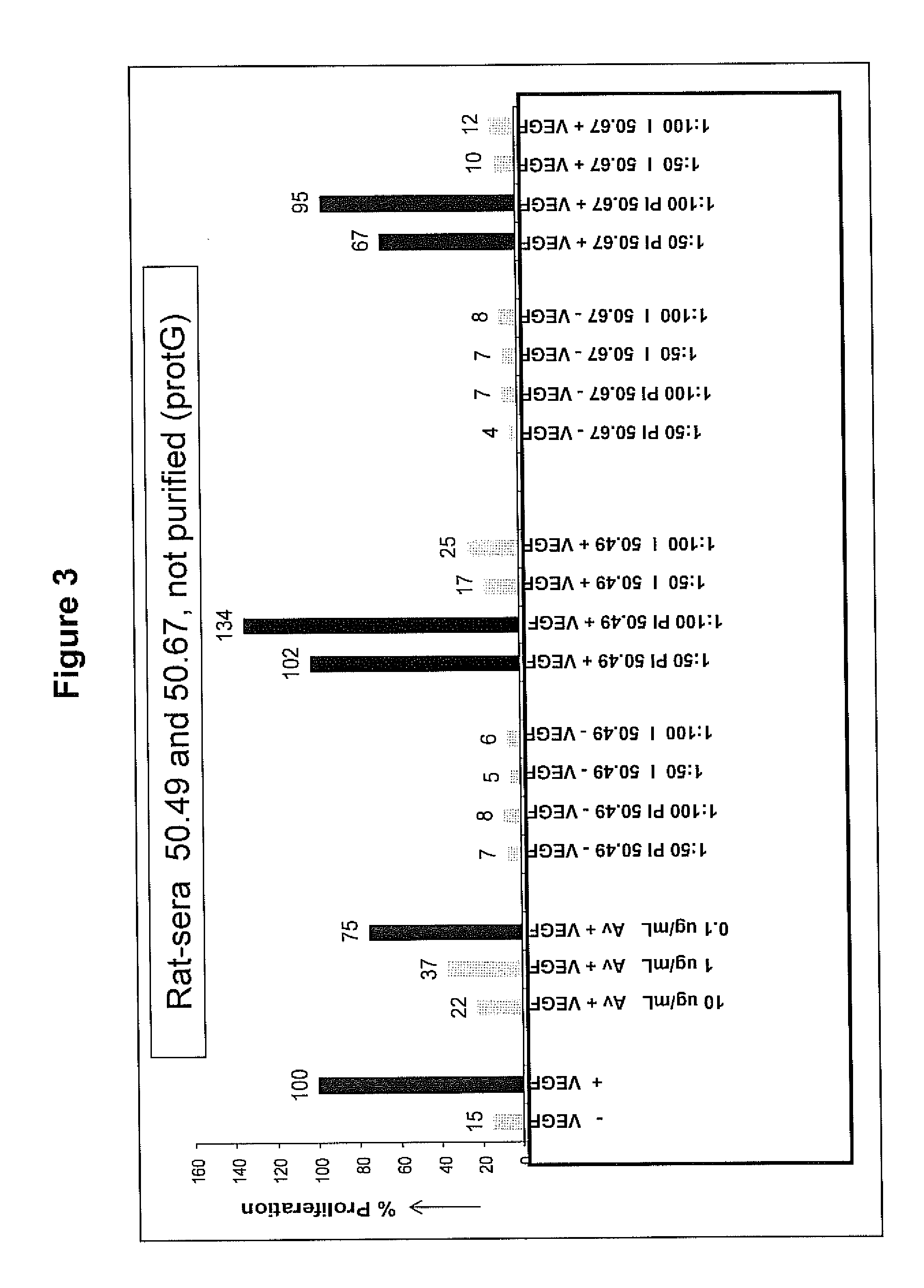Truncated cystine-knot proteins
a cystine-knot protein and truncated technology, applied in the field of protein chemistry, biology and medicine, can solve the problems of low tumor penetration and side effects, high patient burden, and relatively large amount of production costs for treatment, and achieve the effects of reducing tumor burden, reducing tumor burden, and reducing tumor burden
- Summary
- Abstract
- Description
- Claims
- Application Information
AI Technical Summary
Benefits of technology
Problems solved by technology
Method used
Image
Examples
example 1a
Synthesis of Various Forms of VEGF-Truncated
[0142]Three different forms of VEGF-truncated were synthesized:
(SEQ ID NO: 27)humVEGF26-104;__26Ac-C1HPIETLVDIFQEYPDEIEYIFKPSAVPLMRC1GGAC3NDEGLEC4VPTEESNITMQIMRIKPHQGQHIGEMSFLQHNKC5EC6#104(SEQ ID NO: 28)humVEGF25-107;__25Ac-YC1HPIETLVDIFQEYPDEIEYIFKPSAVPLMRC2GGAC3NDEGLEC4VPTEESNITMQIMRIKPHQGQHIGEMSFLQHNKC5EC6RPK#107(SEQ ID NO: 29)humVEGF25-109:__25Ac-YC1HPIETLVDIFQEYPDEIEYIFKPSAVPLMRC2GGSC3NDEGLEC4VPTEESNITMQIMRIKPHQGQHIGEMSFLQHNKC5EC6RPKKD#109
[0143]Amino acids are indicated by the single-letter codes; “Ac” refers to N-terminal acetylation; “#” indicates C-terminal amidation; Cysteines (C1-C6) in boldface indicate cysteines involved in formation of the cystine-knot fold; alanines in boldface indicate native cysteines that were replaced by Ala.
[0144]Three different synthetic procedures were used:
[0145]I. Direct synthesis (Fmoc) of full-length peptide; only used for humVEGF26-104.
[0146]II. Peptide-thioester synthesis using Fmoc-chemistry. Su...
example 1b
Inhibitory Activity of Oxid-humVEGF26-104 in Avastin™-Binding to Surface-Immobilized Oxid-humVEGF1-165
[0163]Binding ELISA: Binding of various mAbs (Avastin™, mAb 293, PDL-antibody) to oxid-humVEGF26-104 and humVEGF1-165 was determined in ELISA. Therefore, polystyrene 96-well plates (Greiner, Germany) were treated with 100 μL / well of 0.2% glutaric dialdehyde in phosphate-buffer (0.1 M, pH=5) for four hours at room temperature while shaking, following by washing (3×10 minutes) with phosphate-buffer (0.1 M, pH=8). Then, the wells were coated with 100 μL / well of a 1 μg / mL solution of oxid-humVEGF26-104 / humVEGF1-165 in phosphate-buffer (0.1 M, pH=8) for three hours at 37° C., followed by overnight standing at room temperature. After washing with 1% TWEEN®-80 (3×), the plates were incubated with the antibody at various different dilutions in horse serum (4% in PBS / 1% TWEEN®-80 / 3% NaCl), starting with 1 / 10 dilution in the first well and three-fold dilution steps in subsequent wells. Incub...
example 1c
Use of Oxid-humVEGF26-104 for Generating VEGF-Neutralizing Antibodies and Sera in Rats and Mice
[0166]Immunization experiments using oxid-humVEGF26-104 (not-conjugated to a carrier protein!!) were carried out both in female Wistar rats and female Balb / C mice. The antisera were analyzed for:[0167]A) binding to surface-immobilized humVEGF1-165 (titer determination)[0168]B) ability to inhibit the binding of Avastin™ to surface-immobilized humVEGF1-165 [0169]C) neutralizing activity for humVEGF1-165 in a BaF3-cell proliferation assay
[0170]The results of these studies are shown below and in FIGS. 3-6.
Immunization Protocols:
[0171]Wistar rats: Female Wistar rats were immunized with anti-humVEGF26-104 at day 0 with 400 μL (intramuscular+subcutaneous, 200 μL each) of a 375 μg / mL solution of humVEGF26-104 in PBS / CoVaccine 1:1 (v / v) (PBS=Phosphate-Buffered Saline), followed by a booster (same quantity and concentration) at two and four weeks. Subsequently, the rats were bled after six weeks and...
PUM
| Property | Measurement | Unit |
|---|---|---|
| concentration | aaaaa | aaaaa |
| concentration | aaaaa | aaaaa |
| pH | aaaaa | aaaaa |
Abstract
Description
Claims
Application Information
 Login to View More
Login to View More - R&D
- Intellectual Property
- Life Sciences
- Materials
- Tech Scout
- Unparalleled Data Quality
- Higher Quality Content
- 60% Fewer Hallucinations
Browse by: Latest US Patents, China's latest patents, Technical Efficacy Thesaurus, Application Domain, Technology Topic, Popular Technical Reports.
© 2025 PatSnap. All rights reserved.Legal|Privacy policy|Modern Slavery Act Transparency Statement|Sitemap|About US| Contact US: help@patsnap.com



